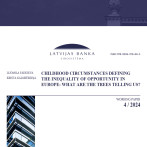Manufacturing growth slows in August
According to the data provided by the Central Statistical Bureau, the amount of manufacturing output at constant prices dropped 3.0% month-on-month in August (seasonal factors excluded). Year-on-year, however, the output amount increased by 4.8%.
The overall drop of production output in August was primarily determined by a substantial drop in output amount in the food industry (10.5% month-on-month), which is hardly a surprise, as it is simply a return to the level of previous months; a positive "maverick" was actually July. As for a more detailed assessment, by food industry sub-branch – it is plain to see that both fruit and vegetable manufacturers and meat producers managed to increase their production output in August, whereas fish processing and canning posted a drop of 35%. Given the situation at hand, the canned fish manufacturers managed to do reasonably well, but August apparently was the month with the greatest drop in production output, which points to problems existing in the industry. Food industry, however, is hardly the only industry in the minuses – production amounts went down noticeably in wood industry (-3.3%), as well as in the production of wearing apparel (-8.8%), textiles (-4.1%), fabricated metal products (-6.8%), electrical equipment (-14.9%), as well as equipment and mechanisms (-3.9%). Growth was notable only in chemical industry (+16.3%) and furniture manufacturing (2.4%). It is obvious that the largest branches performed with substantially more negative rates of growth than industry at large. That means that in branches whose data are not published – metal manufacturing, production of pharmaceuticals and shipbuilding – the output amounts probably grew.
It is worth mentioning that August was a very good month for the energy sector (+7.3%) – which began the year badly. Slightly untypical for the season, cogeneration stations were put in action in August, producing a record amount of electric power for the past few years.
A possible drop in the amount of production output was expected. As I wrote earlier, the rises and falls of sometimes very unsteady branches amounted to positive rates of growth in all of the main industries. Moreover, in some branches they were uncharacteristically good. The rise in previous month and drop in this month, do not, however, much change the outlook on the development of the industry for this year. Namely, the relatively high year-on-year growth rate is ascertained by the resumed operating of "KVV Liepājas metalurgs", as well as the good performance of wood industry. The results were also good (judging by the public reports) in the pharmaceuticals branch. They are weak, however, in the sanction-affected food industry and construction-weakness-affected production of construction materials. The so-called hi tech branches – production of computers and optical equipment, the production of electrical equipment and mechanisms – continue to post good performance, which continues to improve, regularly attaining new output records.
In 2015 overall, the amount of manufacturing output could increase by 5-6%. Future growth of the industry will depend on developments in the external environment, including the recovery of the euro area and the geopolitical situation. The external situation is also impacted by the slowing of the Chinese economy, which, albeit not affecting Latvia's economy in any crucial way, has an effect on the global goods and raw materials markets, in which Latvia competes with its products. The geopolitical factor is of crucial importance as regards industry confidence and making new investments. There is another important factor: Latvian manufacturing is still very sensitive to external shocks. Namely, two of its largest sub-branches (wood industry and food industry) are responsible for almost one half of total industrial output. In relaxed times, it is not bad, but if there are shocks (recent sanctions are a good example), the countries whose manufacturing is not highly diversified (and is oriented toward export instead of supplying the domestic market) suffer most. Therefore, the economic policy makers have to give more thought to the instruments with which the diversification of manufacturing could be stimulated.
Textual error
«… …»






